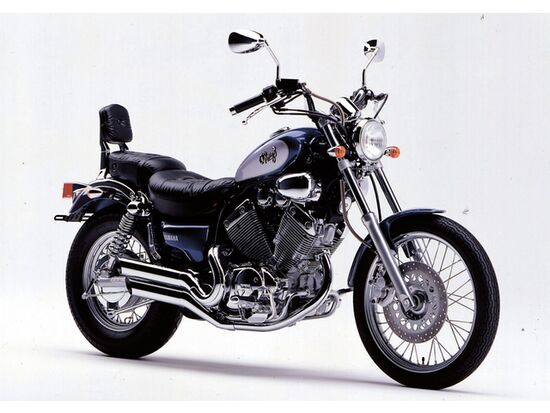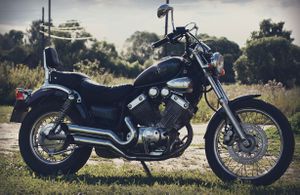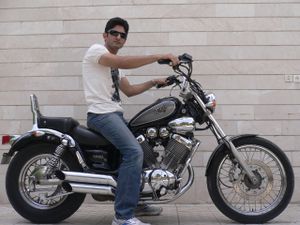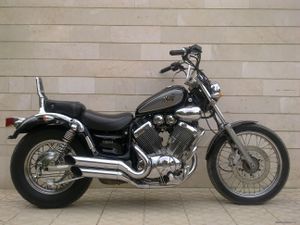Difference between revisions of "Yamaha XV400 Virago"
m |
m |
||
| (8 intermediate revisions by the same user not shown) | |||
| Line 1: | Line 1: | ||
| − | {{DISPLAYTITLE:Yamaha Virago 400 | + | {{DISPLAYTITLE: Yamaha Virago 400}} |
| − | |||
| − | |||
| − | |||
| − | }} | ||
__notoc__ | __notoc__ | ||
| − | + | [[file: Xv400 mod2.jpg | 550px | center | Yamaha Virago 400 (2NU, 3JB2, 3JB4, 3JB6, 3JB8)]] | |
| − | + | The Yamaha Virago 400 was introduced in March 1987 for the Japanese domestic market. The model is based on the export version [[Yamaha_XV535_Virago | Yamaha Virago 535]] and has a lot in common with it. The main differences are in the engine and some other technical characteristics. | |
| − | + | {{Ads_top}} | |
| − | + | The basis for the Yamaha XV400 Virago was a 2-cylinder V-twin air-cooled engine, 399 cc, producing 40 hp. power and 34 Nm of torque. The motor is quick enough for a model of this class, but typical for a motorcycle of this size. The maximum performance is at 7000-8500 rpm. | |
| − | |||
| − | |||
| − | + | In general, the motorcycle has a simple layout with a steel backbone frame (engine-carrying part), conventional suspensions, cardan drive, front disc and rear drum brakes, and a 5-speed gearbox. | |
| − | + | '' The main modifications of the Yamaha XV400 Virago: '' | |
| + | * Yamaha Virago 400 (factory codes - '''2NU, 3JB2, 3JB4, 3JB6, 3JB8''') - classic version with curved steering wheel. | ||
| + | * Yamaha Virago 400 (factory codes - '''2NT, 3JB1, 3JB3, 3JB5, 3JB7''') - version with a straight steering wheel. | ||
| − | + | In 1989, the model receives a small change regarding the increase in the fuel tank (the false tank receives the functions of a real fuel tank, which increases the total capacity to 13.5 liters). | |
| − | |||
| − | |||
| − | + | In 1994, the motorcycle received a perforated front brake disc and a 2-piston caliper (instead of a 1-piston). The same year was the last year of the model's production. Currently, the Yamaha XV400 Virago is widely represented at Japanese auctions and is one of the most affordable cruisers in its cubic capacity. | |
| − | + | In 1996, a completely updated model was proposed as the successor to the Yamaha Virago 400 - [[Yamaha_XVS400_Drag_Star | Yamaha XVS400 Drag Star]]. | |
| − | + | The "little brother" of the Yamaha Virago 400 model is [[Yamaha_XV250_Virago | Yamaha XV250 Virago (V-Star 250)]]. | |
| − | + | '' The main competitors of the Yamaha Virago 400 in the class: '' | |
| + | * [[Honda_Steed_400 | Honda Steed 400]] | ||
| + | * [[Suzuki_VS400_Intruder | Suzuki Intruder 400]] | ||
| + | * [[Kawasaki_VN400_Vulcan | Kawasaki VN 400 Vulcan]] / [[Kawasaki_EN400_Vulcan | Kawasaki EN 400 Vulcan]] | ||
| − | + | == Photos == | |
| − | + | {| align = "center" border = "0" | |
| − | + | | [[Image: 2Pv6U9339zc.jpg | 300px | thumb | Yamaha Virago 400]] | |
| − | + | | [[Image: 2010-06-26-bikepics-2006160-full.jpg | 300px | thumb | Yamaha Virago 400]] | |
| − | + | | [[Image: Bikepics-1973103-full.jpg | 300px | thumb | Yamaha Virago 400]] | |
| − | == | ||
| − | {| align="center" border="0" | ||
| − | |[[Image:2Pv6U9339zc.jpg|300px|thumb|Yamaha Virago 400]] | ||
| − | |[[Image:2010-06-26-bikepics-2006160-full.jpg|300px|thumb|Yamaha Virago 400]] | ||
| − | |[[Image:Bikepics-1973103-full.jpg|300px|thumb|Yamaha Virago 400]] | ||
|- | |- | ||
|} | |} | ||
| − | == | + | {{Ads_feed}} |
| − | + | {{Ads_post}} | |
| − | {| class="wikitable" | + | |
| − | ! scope="row"| | + | == Specifications == |
| − | |Yamaha XV400 Virago | + | Specifications Yamaha Virago 400: |
| + | {| class = "wikitable" | ||
| + | ! scope = "row" | Model | ||
| + | | Yamaha XV400 Virago | ||
|- | |- | ||
| − | ! scope="row"| | + | ! scope = "row" | Motorcycle type |
| − | | | + | | cruiser |
|- | |- | ||
| − | ! scope="row"| | + | ! scope = "row" | Release year |
| − | |1987-1994 | + | | 1987-1994 |
|- | |- | ||
| − | ! scope="row"| | + | ! scope = "row" | Frame |
| − | | | + | | steel backbone (engine - carrying part) |
|- | |- | ||
| − | ! scope="row"| | + | ! scope = "row" | Engine type |
| − | |2- | + | | 2-cylinder, 4-stroke, V-shaped |
|- | |- | ||
| − | ! scope="row"| | + | ! scope = "row" | Working volume |
| − | |399 | + | | 399 cm³ |
|- | |- | ||
| − | ! scope="row"| | + | ! scope = "row" | Bore / stroke |
| − | |68 | + | | 68.0 x 55.0 mm |
|- | |- | ||
| − | ! scope="row"| | + | ! scope = "row" | Compression ratio |
| − | |9.7:1 | + | | 9.7: 1 |
|- | |- | ||
| − | ! scope="row"| | + | ! scope = "row" | Cooling |
| − | | | + | | air |
|- | |- | ||
| − | ! scope="row"| | + | ! scope = "row" | Number of valves per cylinder |
| − | |SOHC, 2 | + | | SOHC, 2 valves per cylinder |
|- | |- | ||
| − | ! scope="row"| | + | ! scope = "row" | Fuel supply system |
| − | | | + | | carburetor, 2x Mikuni BDS34 |
|- | |- | ||
| − | ! scope="row"| | + | ! scope = "row" | Ignition type |
| − | | | + | | transistor TCI |
|- | |- | ||
| − | ! scope="row"| | + | ! scope = "row" | Maximum power |
| − | |40 | + | | 40.0 h.p. (29.4 kW) at 8500 rpm |
|- | |- | ||
| − | ! scope="row"| | + | ! scope = "row" | Maximum torque |
| − | |34 | + | | 34.3 Nm (3.5 kgf * m) @ 7000 rpm |
|- | |- | ||
| − | ! scope="row"| | + | ! scope = "row" | Gearbox |
| − | |5- | + | | 5-speed |
|- | |- | ||
| − | ! scope="row"| | + | ! scope = "row" | Drive type |
| − | | | + | | cardan |
|- | |- | ||
| − | ! scope="row"| | + | ! scope = "row" | Front tire size |
| − | |3.00-19 49S | + | | 3.00-19 49S |
|- | |- | ||
| − | ! scope="row"| | + | ! scope = "row" | Rear tire size |
| − | |140/90-15M/C (70S) | + | | 140 / 90-15M / C (70S) |
|- | |- | ||
| − | ! scope="row"| | + | ! scope = "row" | Front brakes |
| − | |1 | + | | 1 disc, 298mm, 1-piston caliper - Virago 400 (1987-1993) |
| − | + | Single disc, 298 mm, 2-piston caliper - Virago 400 (1994) | |
|- | |- | ||
| − | ! scope="row"| | + | ! scope = "row" | Rear brakes |
| − | | | + | | drum |
|- | |- | ||
| − | ! scope="row"| | + | ! scope = "row" | Front suspension |
| − | | | + | | telescopic fork, travel 150 mm |
|- | |- | ||
| − | ! scope="row"| | + | ! scope = "row" | Rear suspension |
| − | | | + | | linkage with two shock absorbers, stroke - 85 mm |
|- | |- | ||
| − | ! scope="row"| | + | ! scope = "row" | Motorcycle length |
| − | |2225 | + | | 2225 mm |
|- | |- | ||
| − | ! scope="row"| | + | ! scope = "row" | Motorcycle width |
| − | |725 | + | | 725 mm - Virago 400 (2NT, 3JB1, 3JB3, 3JB5, 3JB7) |
| − | 800 | + | 800 mm - Virago 400 (2NU, 3JB2, 3JB4, 3JB6, 3JB8) |
|- | |- | ||
| − | ! scope="row"| | + | ! scope = "row" | Motorcycle height |
| − | |1055 | + | | 1055 mm - Virago 400 (2NT, 3JB1, 3JB3, 3JB5, 3JB7) |
| − | 1115 | + | 1115 mm - Virago 400 (2NU, 3JB2, 3JB4, 3JB6, 3JB8) |
|- | |- | ||
| − | ! scope="row"| | + | ! scope = "row" | Wheelbase |
| − | |1520 | + | | 1520 mm |
|- | |- | ||
| − | ! scope="row"| | + | ! scope = "row" | Saddle height |
| − | |700 | + | | 700 mm |
|- | |- | ||
| − | ! scope="row"| | + | ! scope = "row" | Acceleration to 100 km / h |
| − | |7 | + | | 7.5 sec |
|- | |- | ||
| − | ! scope="row"| | + | ! scope = "row" | Maximum speed |
| − | |135 | + | | 135 km / h |
|- | |- | ||
| − | ! scope="row"| | + | ! scope = "row" | Fuel tank capacity |
| − | |8 | + | | 8.6 L - Virago 400 (1987-1988) |
| − | 13 | + | 13.5 L (including 2.5 L reserve) - Virago 400 (1989-1994) |
|- | |- | ||
| − | ! scope="row"| | + | ! scope = "row" | Motorcycle weight (dry) |
| − | |178 | + | | 178 kg |
| − | |||
| − | |||
| − | |||
| − | |||
| − | |||
| − | |||
| − | |||
| − | |||
| − | |||
| − | |||
|- | |- | ||
|} | |} | ||
| − | == | + | == Documentation == |
| − | + | [[Category:Motorcycles]] | |
| + | * [[Yamaha_XV400_Virago:_manuals|Yamaha XV400 Virago]] | ||
| − | == | + | == == |
| − | + | {{Ads_recomended}} | |
Latest revision as of 21:39, 15 August 2021
The Yamaha Virago 400 was introduced in March 1987 for the Japanese domestic market. The model is based on the export version Yamaha Virago 535 and has a lot in common with it. The main differences are in the engine and some other technical characteristics.
The basis for the Yamaha XV400 Virago was a 2-cylinder V-twin air-cooled engine, 399 cc, producing 40 hp. power and 34 Nm of torque. The motor is quick enough for a model of this class, but typical for a motorcycle of this size. The maximum performance is at 7000-8500 rpm.
In general, the motorcycle has a simple layout with a steel backbone frame (engine-carrying part), conventional suspensions, cardan drive, front disc and rear drum brakes, and a 5-speed gearbox.
The main modifications of the Yamaha XV400 Virago:
- Yamaha Virago 400 (factory codes - 2NU, 3JB2, 3JB4, 3JB6, 3JB8) - classic version with curved steering wheel.
- Yamaha Virago 400 (factory codes - 2NT, 3JB1, 3JB3, 3JB5, 3JB7) - version with a straight steering wheel.
In 1989, the model receives a small change regarding the increase in the fuel tank (the false tank receives the functions of a real fuel tank, which increases the total capacity to 13.5 liters).
In 1994, the motorcycle received a perforated front brake disc and a 2-piston caliper (instead of a 1-piston). The same year was the last year of the model's production. Currently, the Yamaha XV400 Virago is widely represented at Japanese auctions and is one of the most affordable cruisers in its cubic capacity.
In 1996, a completely updated model was proposed as the successor to the Yamaha Virago 400 - Yamaha XVS400 Drag Star.
The "little brother" of the Yamaha Virago 400 model is Yamaha XV250 Virago (V-Star 250).
The main competitors of the Yamaha Virago 400 in the class:
Photos
Specifications
Specifications Yamaha Virago 400:
| Model | Yamaha XV400 Virago |
|---|---|
| Motorcycle type | cruiser |
| Release year | 1987-1994 |
| Frame | steel backbone (engine - carrying part) |
| Engine type | 2-cylinder, 4-stroke, V-shaped |
| Working volume | 399 cm³ |
| Bore / stroke | 68.0 x 55.0 mm |
| Compression ratio | 9.7: 1 |
| Cooling | air |
| Number of valves per cylinder | SOHC, 2 valves per cylinder |
| Fuel supply system | carburetor, 2x Mikuni BDS34 |
| Ignition type | transistor TCI |
| Maximum power | 40.0 h.p. (29.4 kW) at 8500 rpm |
| Maximum torque | 34.3 Nm (3.5 kgf * m) @ 7000 rpm |
| Gearbox | 5-speed |
| Drive type | cardan |
| Front tire size | 3.00-19 49S |
| Rear tire size | 140 / 90-15M / C (70S) |
| Front brakes | 1 disc, 298mm, 1-piston caliper - Virago 400 (1987-1993)
Single disc, 298 mm, 2-piston caliper - Virago 400 (1994) |
| Rear brakes | drum |
| Front suspension | telescopic fork, travel 150 mm |
| Rear suspension | linkage with two shock absorbers, stroke - 85 mm |
| Motorcycle length | 2225 mm |
| Motorcycle width | 725 mm - Virago 400 (2NT, 3JB1, 3JB3, 3JB5, 3JB7)
800 mm - Virago 400 (2NU, 3JB2, 3JB4, 3JB6, 3JB8) |
| Motorcycle height | 1055 mm - Virago 400 (2NT, 3JB1, 3JB3, 3JB5, 3JB7)
1115 mm - Virago 400 (2NU, 3JB2, 3JB4, 3JB6, 3JB8) |
| Wheelbase | 1520 mm |
| Saddle height | 700 mm |
| Acceleration to 100 km / h | 7.5 sec |
| Maximum speed | 135 km / h |
| Fuel tank capacity | 8.6 L - Virago 400 (1987-1988)
13.5 L (including 2.5 L reserve) - Virago 400 (1989-1994) |
| Motorcycle weight (dry) | 178 kg |
Documentation



